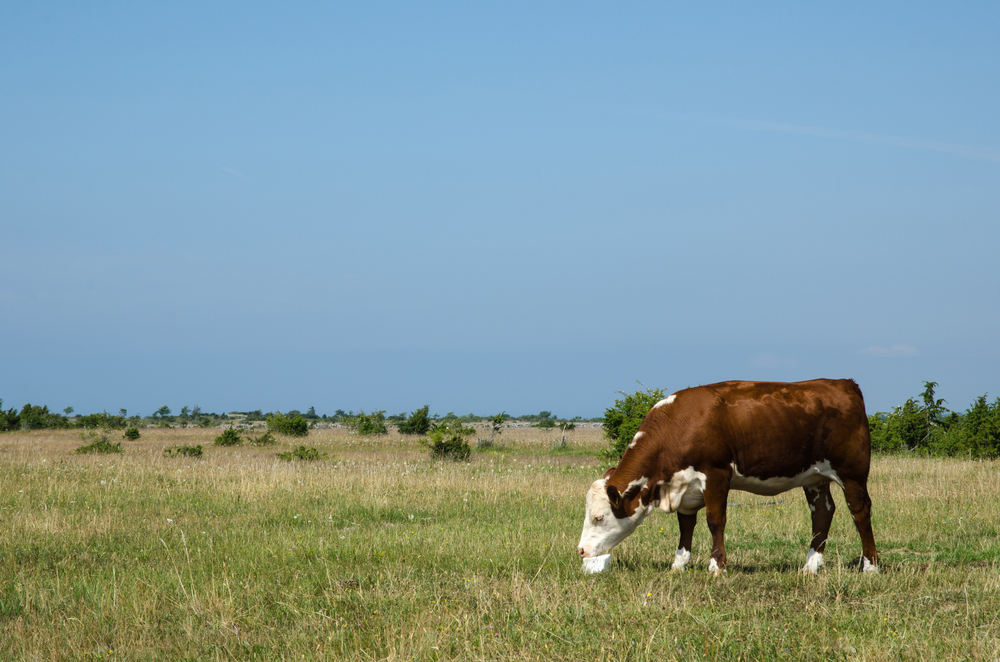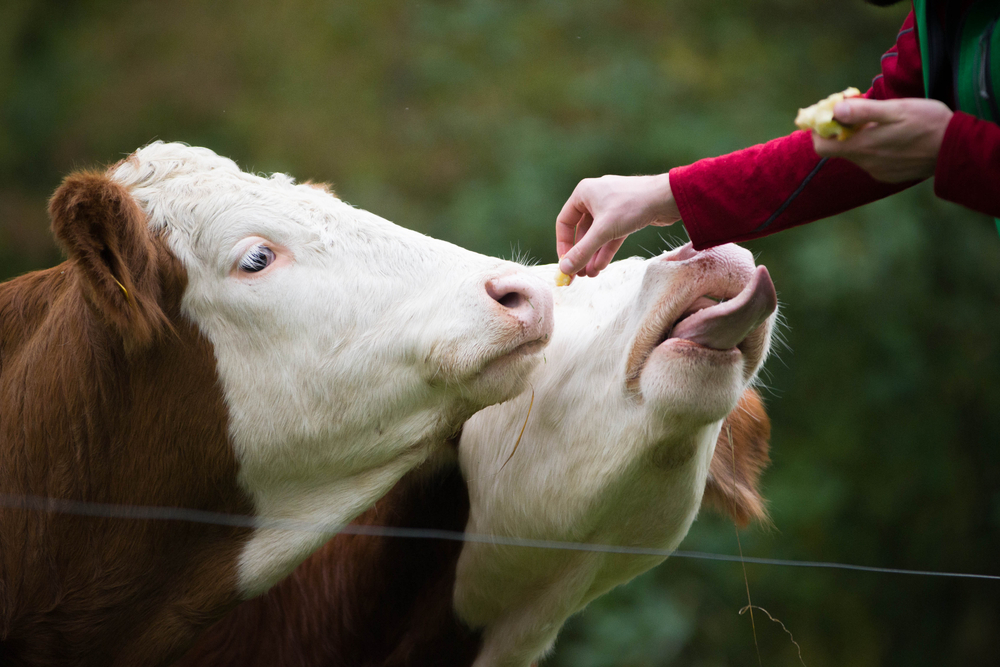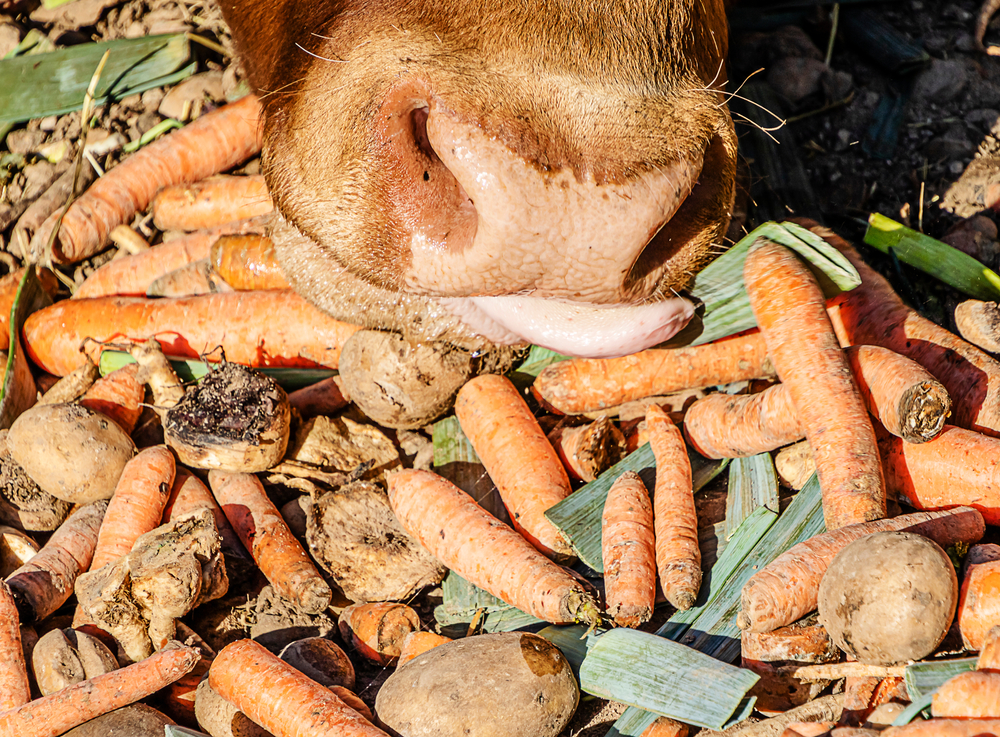For cow owners, it is vital to know what nutritional and dietary needs these majestic animals need. Cows are an iconic animal in U.S. agriculture and are known for their grazing habits — but what kinds of treats do cows enjoy?
Knowing what types of treats to feed your cows is the key to creating a balanced and nutritious diet that benefits your cows’ health and well-being.
In this article, we look at what types of feed cows can eat as treats and the importance of using treats as an enrichment activity for cows. We cover which feeds make excellent cow treats and which foods to avoid.
Keep reading to learn all about feeding your cows healthy treats!
Jump Links
- Understanding the Dietary Needs & Preferences of Cows
- Treats for Cows: The Importance of Enrichment Treats
- 7 Common Treats that Cows Love to Eat
- Foods & Treats to Avoid Feeding to Cows
- Final Thoughts: Make Treats a Fun Part of Your Cow’s Balanced Diet
Understanding the Dietary Needs & Preferences of Cows
Like all animals, cows require a balanced diet of multiple nutrients.
According to a 2020 National Library of Medicine study on the nutrition and feeding of dairy cattle, proper nutrition starts when a cow is still a calf and is the key to maximizing milk production. Even if a cow is not used to produce milk, a balanced diet is essential for their health.
The study further states that dairy cows need a diet of carbohydrates, amino acids, fatty acids, minerals, vitamins, and adequate water. Without these nutrients, a dairy cow’s mammary gland may not be able to yield as much milk as a well-fed, healthy cow.
As for other types of cows, the story is largely the same. Beef cows and other cattle need the above-listed nutrients to live healthy lives and produce healthy byproducts like meat and milk.
Why Grass & Hay are Dietary Staples for Cows?
Cows are considered herbivores and prefer to eat plant-based foods like grains, fruits, and vegetables.
Regarding what plant-based foods cows most commonly eat, grasses and hay are an undeniable staple in any cow’s diet. Grass and hay are dietary staples for cows because of the nutritional value of these foods and their affordability for farmers.
For instance, during the spring and summer, cows can munch on naturally grown grass in their pastures. This pasture grass is a tremendous source of nutritional value that is cheap for farmers to grow.
On the other hand, Hay is a great option to feed cows during the colder months or if the grass is struggling to grow in sufficient amounts in a cow pasture. There are many different types of grasses and hays that you can feed to cows, including:
- Alfalfa hay
- Timothy hay
- Orchardgrass
- Brome (also called smooth bromegrass)
- Tall fescue
- Ryegrass
- Bluegrass
If you are new to owning cows and need help selecting the best types of grasses and hay to feed your cows, the best place to start is at your veterinarian. A professional cattle veterinarian can help determine the specific nutritional needs of your cows, as well as recommend grass and hay varieties that are easy to obtain within your local area or region.
Though grass and hay often comprise the largest portion of a cow’s diet, many farmers feed their cattle various grains. Corn, oats, and barley are the most popular grain for cows. These grains can be an extra source of protein, dietary fiber, and carbohydrates for your cows.
Treats for Cows: The Importance of Enrichment Treats
Who doesn’t love a yummy daily treat? Just as we humans love to snack on treats, so do cows. Feeding treats to cows can be a great way to add extra nutritional value to their daily diet while also giving them energy and happiness.
Although cows do not experience emotions in the same way as humans, these animals can still experience bouts of dissatisfaction, boredom, and even depression. Research has shown that cows are fond of learning and can have “Eureka!” moments after spontaneous problem-solving.
How does this relate to treats? It all comes down to enrichment. Adding enrichment toys and treats to your cows’ pasture can help you keep your cows happily snacking and engaging with a learning activity. With the right enrichment toys and treats, you can ward off boredom and dissatisfaction in your cows.
Two of the best enrichment treat options for cows include salt blocks and frozen produce. These treats present your cows with a challenge that rewards their engagement with a salty or sweet treat.

As for non-treat enrichment toys, good options to add to your pasture include scratch posts, hanging ropes, or loose piles of hay. If you opt for the piles of hay, you can also add scented essential oils that make the pile more exciting and pleasant for a cow to rummage through.
7 Common Treats that Cows Love to Eat
Regarding treats that your cows will love to eat, the possibilities are nearly endless. Choosing the right treats for your cows can depend on their preferences. Every cow has a unique personality and different preferences for what they like to eat.
If you are raising many cows, it may be difficult to identify these preferences. However, taking the time to try and get to know your cows individually can help you buy the foods they want most and enhance your cows’ overall experience and well-being. With this in mind, here are seven treats that cows love to snack on:
1. Apples
Apples are widely known as cow-friendly fruits. Cows get more dietary fiber and carbs in their daily diet by eating apples. However, it is important to note that apples need to be fed in moderation to cows. A cow consuming too many apples daily can lead to digestive issues like bloating.

Additionally, cows can eat partially-fermented apples, making apples that are beginning to spoil a good treat to throw out to your cows instead.
2. Carrots
Cows love almost any kind of root vegetable, but especially carrots. Carrots are a good source of energy for cows. Best of all, cows can eat a plethora of carrots per day. These vegetables do not need to be consumed in the same moderation as apples, with one cattle report from Michigan State University revealing that cows can eat up to 35 lbs. of carrots per day.
Regarding our earlier discussion of treat and toy enrichment for cows, carrots can be an excellent addition to your enrichment strategy. For example, if you have hanging ropes for your cows to play with, you can tie a carrot to the end for them to snack on while they play.

3. Oats
Oats are not only a dietary staple for cows but can also be a fantastic treat. One of the reasons why oats are so great for cows is that they are high in fiber. Many farmers use oats as an introductory grain to feed calves as they grow.
In terms of how to use oats as a treat, you have several options. Oat Baas is a snack bar made primarily from oats and molasses. The molasses helps the oats stick together to form the bar while also sweetening and flavoring the bar. These treats can then be hand fed to your cows the next time you visit.
4. Turnips
Turnips are another favorite food to feed calves. These root vegetables are thought to offer similar health benefits as oats, helping to promote healthy growth and energy in young cows.
What’s great about turnips is they can be grown within the pasture itself, allowing your cows to snack on the turnips after they have grown. However, it may be smart to keep your turnips in a separate grazing pasture from your cows’ main pasture to give the turnips time to grow and prevent your cows from overindulging in these yummy root veggies.
5. Potatoes & Potato Peels
Preheat your oven and prepare to bake because your cows love baked potatoes.
Raw potatoes can be an okay treat for cows in moderation, but their natural starches can make them hard to digest in their raw form. However, when cooked, potatoes make a delicious treat for cows.
Potato peels are a great source of nutrients that can be added to your cows’ daily feed. As such, the next time you whip out your peeler to make a batch of mashed potatoes, set those peels to the side to give your cows later.
6. Pumpkins
Pumpkins can be a fantastic enrichment treat for cows, generally considered healthy and easy to digest. Of course, if this is your first time feeding your cows pumpkins, you should serve the vegetable in moderation to give your cows’ digestive systems time to adjust to the new food.
What makes pumpkins great is that they can help promote better gut health in your cows. Pumpkins are believed to contain a compound called cucurbitacin, which helps to expel and prevent tapeworms in the digestive systems of many different kinds of livestock, including cows.
Just make sure the pumpkins do not spoil before they are eaten. If you notice any spoiled pumpkins in your pasture, remove them and replace them with fresh pumpkins.
7. Bananas
Bananas are an all-around healthy treat for both cows and humans alike. With just one banana, you can provide your cow with essential nutrients like carbohydrates, vitamin B6, and natural sugars that boost your cow’s internal health. Additionally, bananas are a good source of potassium, which can assist in maintaining your cow’s joint health and flexibility.
Peeled and frozen bananas can be a good option for a frozen enrichment treat. The peels can also benefit cows, though you should cut them up to avoid choking hazards.
8. Corn
Corn is an interesting food for cows, as it is highly versatile. Corn can serve as a core dietary staple within your cows’ feed and be a good crop for enhanced grazing. After harvesting corn, the leftover corn stalks make great grazing materials, with cows happily eating the stalks and leaves of the crops.

9. Salt Licks
As we mentioned earlier, a salt lick is one of the best enrichment treats for cows. Salt licks (also called mineral licks) are large blocks made of salt deposits and other minerals. These blocks are placed on the ground for cows to lick and chew on and are typically placed in the feeding area.
Getting your cows all the necessary minerals can be difficult when their diets consist mainly of grasses, hay, and grains. Considering most treats need to be fed in moderation, you cannot rely on treats as a main source of minerals, either. Thus, salt licks provide a source of both essential minerals and fun for your cows to enjoy.
Sugar, Candy, & Molasses, Oh My! A Quick Look at Sugary Treats for Cows
If you have ever spent time around farmers who raise cows, you may have heard them talk about feeding their cows sugary treats like candy or cookies.
In moderation, candies like chocolate bars and gummy worms can be a good substitute for corn, as they provide similar nutritional value. A 2017 report from the U.S. Department of Agriculture states that cows have bacteria in their rumen (the largest stomach compartment) that break down corn and candy similarly, making candy a generally safe substitute for corn.
Aside from candy, molasses is a very common sugary treat to feed to cows. It is best for making DIY treats at home for your cows, as it helps to form ingredients like oats or mashed apples into bars. As you would in your diet, make sure to feed cows sugary treats in moderation.
Foods & Treats to Avoid Feeding to Cows
While plenty of foods make delicious and healthy treats for cows, there are also a variety of foods to avoid. Specifically, plants in the Brassica genus, like cabbage, onions, beans, and amaranthus, can be toxic to cows and should be avoided.
If your cows are housed in a pasture with Brassica crops, it’s not the end of the world — however, you should try to prevent your cows from disturbing these crops with extra fencing.
Several non-edible plants must also be kept away from cows at all costs. These include lupine, death camas, nightshades, poison hemlock, water hemlock, and larkspurs.
The most important consideration when dealing with foods that are toxic or poisonous to cows is to know the symptoms to watch out for. When a cow is poisoned, it may display symptoms such as:
- Excessive nervousness
- Excessive salivation
- Notable depression, lethargy, or general lack of energy
- Twitching and convulsions
- Difficulty moving and breathing
- Vomiting
Contact your veterinarian immediately if your cows begin displaying any of these symptoms.
Final Thoughts: Make Treats a Fun Part of Your Cow’s Balanced Diet
No matter what treats you feed your cows, the biggest takeaway is ensuring those treats are part of a balanced, healthy diet.
Whether you are raising dairy cows or beef cattle — or if you are the rare farmer that keeps cows as pets — providing your cows with a balanced diet is the key to extending their life. Plus, if you are raising cows to produce dairy and meat products, a balanced diet is essential for ensuring the quality of those products down the road.
Our final tip for feeding your cows treats is always to involve your veterinarian in the process. Running any new treat ideas by your vet first is the best way to know whether or not it is a healthy and safe choice for your cows.

